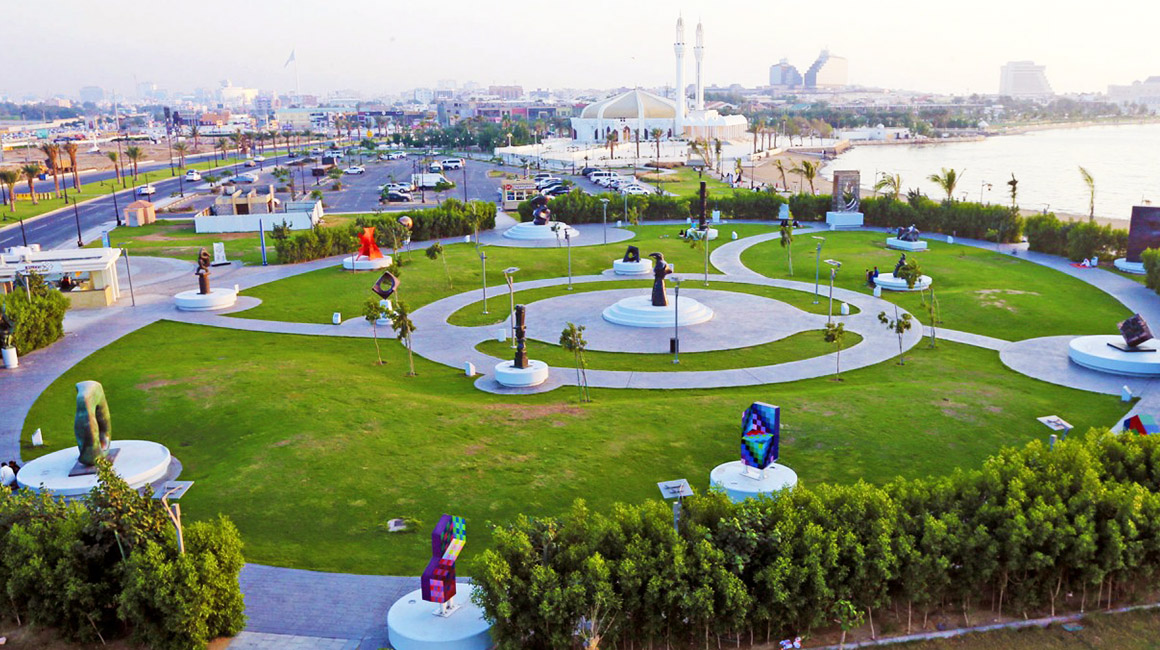Who doesn’t love to spend time outside? Thankfully, Saudi offers more than just adventure and sport outdoors — it also boasts a wide variety of impressive art. With a massive outdoor sculpture park in Jeddah, urban art labs on the way in Riyadh and calligraphy street art popping up across Arabia, visitors won’t have to look hard for an artsy spot to ’gram. Plus, Saudi’s outdoor art installations present an opportunity to both play and learn something new, which is pretty hard to beat.
Jeddah’s Sculptures

Fans of outdoor art should add Jeddah to their bucket lists, thanks in big part to the city’s former mayor Mohamed Said Farsi, who served from 1972 to 1986. Farsi was inspired by his time at university in Alexandria, Egypt, and he had a passion for civic planning and a dream of beautifying Jeddah. He spent a decade acquiring noteworthy works of art from regional and international artists, and his efforts paid off. Farsi secured 400 statues by the likes of Henry Moore, Victor Vasarely, Mustafa Senbel, Joan Miró, Jean Arp and more to install around Jeddah’s Corniche and across the city.
Tip: Use this map to find statues like Julio Lafuente’s Accident! (Crazy Speed), featuring five cars crashing into a concrete block, in the Northern Corniche, Obhur district, or Mustafa Senbel’s The Fisherman’s Net in the Central Corniche, Ruwais district.
Jeddah Outdoor Sculpture Park

As time went on, the elements — sand, salt and heat — were beginning to take their toll on many of the works Farsi had commissioned, so in 2011 the Municipality of Jeddah and the cultural institution Art Jameel began a large-scale restoration project. This effort included relocating 21 statues to Jeddah’s Corniche to form the largest open-air museum in Saudi, also known as Al Hamraa. Enjoy the breeze coming off the Red Sea while you stroll through this 7-square-kilometer park on the corniche. Here you’ll find several pieces by Henry Moore, including Oval With Points, and Victor Vasarely, whose Balance in Air features his signature geometric shapes and playful colors.
Farsi met Vasarely in 1981 and later wrote: “From our first conversation, I sensed his youthful, vigorous and enterprising spirit. He was enthusiastic about continuously presenting new ideas so as to keep pace with our fast-moving world and believed that as new art materials became available they should be used on advertising hoardings, at subways stations, bus stops and the like. Popular culture, he argued, should be seen by the people — wherever they might be.”
Year of Calligraphy

In 2020, Saudi’s Ministry of Culture launched The Year of Arabic Calligraphy as an initiative for people, businesses, government agencies and nonprofits to share ideas for promoting the art of Arabic calligraphy. Fruits of this initiative are popping up in the form of street art in Riyadh’s tunnels and roadways as well as in beautification efforts on Makkah Road in Sakaka. The Ministry of Culture also launched a free e-learning platform for Arabic calligraphy and Islamic decorative arts as a part of the Year of Arabic Calligraphy celebration.
Mirrored Art Installation and More

Maraya, which translates to “mirror” in English, is a 5,000-square-meter cube that reflects the desertscapes surrounding it in AlUla. Its awe-inspiring exterior is worth a visit even if you don’t go inside — but you should go inside too, as Maraya serves as a center for concerts, interactive exhibitions, immersive theater and more. Behind the stage, a large retractable window, which is more than 800 square meters, opens up to reveal AlUla’s landscapes.
Looking Ahead: Art Riyadh Project

One of four major well-being projects underway in Saudi’s capital, the Art Riyadh project is set to transform the city into an open gallery, enabling opportunities for new creative expression, engagement of local and international members of the art community, knowledge transfer and more. The goal? Deliver more than 1,000 installation pieces and landmarks throughout Riyadh’s public spaces, such as residential neighborhoods, parks and gardens, public transportation stations and traffic stops. Art will also be installed on bridges, at entrances to the city and near existing tourist attractions in town. So far, 11 subprojects have been defined as a part of this ambitious Vision 2030 effort, and they include:
- Urban Art Lab: Galleries in city squares featuring the work of well-known artists that facilitate conversations between artists and Riyadh residents
- The Joyous Gardens: Playgrounds designed by famous artists for neighborhood gardens
- Jewels of Riyadh: Prized artworks to be installed near tourist attractions
- Welcoming Gateways: Impressive and unique gateway entrances to the city
- Art on the Move: Sculpture installations added at major traffic intersections
- Art in Transit: Artworks to be displayed in bus and metro stations
- Urban Flow: Artistic pedestrian bridges designed to inspire increased interconnectivity across the city and encourage walking
- The Hidden River: Artful illumination on bridges and viaducts
- Garden City: A permanent collection of art and sculpture in a central Riyadh garden
- Riyadh Icon: A unique landmark to help make the city of Riyadh recognizable
- Noor Festival: An annual event to showcase interactive art rooted in illumination
Hey!
Log In or Sign Up to save your favorite attractions